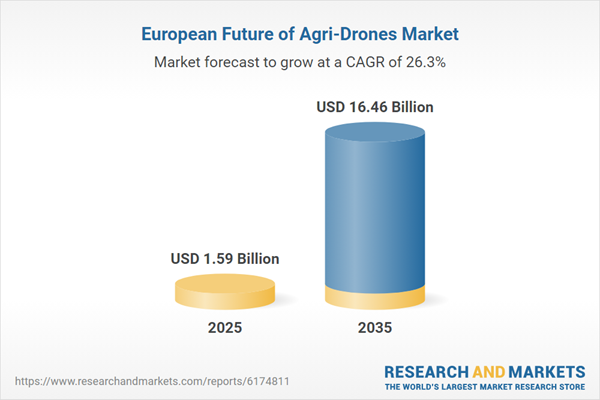The Europe Future of Agri-Drones Market Expected to Reach $16,462.0 Million by 2035
This report comes with 10% free customization, enabling you to add data that meets your specific business needs.
As labor shortages worsen, automation is progressing, with autonomous drones decreasing reliance on manual labor in the field. Large-scale, coordinated farming operations are made possible by emerging technologies like swarm technology, and predictive analytics and evidence-based decision-making are improved by integration with IoT and big data platforms.
Drone activities are being formalized at the same time by Europe's developing regulatory frameworks under the EASA, which have standardized certification and airspace usage procedures. Agri-drones are positioned as a key component of next-generation European agriculture as a result of these trends, which collectively demonstrate the convergence of technology, sustainability, and data intelligence.
Market Introduction
The market for agri-drones in Europe is expanding quickly due to the growing use of smart farming and precision agriculture technology. Farmers may increase crop output, lower operating costs, and maximize resource use by using agri-drones for precision spraying, soil analysis, insect identification, and crop monitoring. Agricultural drones that incorporate AI, IoT, and machine learning enable automated decision-making, predictive analytics, and real-time data collection, thereby promoting climate-smart and sustainable farming methods.The transition to autonomous drones, which reduce the need for manual labor for repetitive tasks, is being accelerated by labor shortages in European agriculture. The market expansion is further reinforced by government programs and subsidies that support digital farming solutions. Swarm drones, high-resolution image sensors, and variable-rate spraying systems are examples of innovations that are improving crop health management, efficiency, and precision.
In Europe, yield estimation, field mapping, disease and pest detection, and irrigation management are some of the main uses for agri-drones. Leading nations like Germany, France, and the Netherlands are early adopters, using cutting-edge technologies to sustainably meet the world's expanding food demand. The market for agri-drones in Europe is expected to increase significantly due to ongoing technological developments and growing awareness of precision farming, making it an essential part of the region's digital agriculture revolution.
Market Segmentation:
Segmentation 1: by Application
- Crop Monitoring/Scouting
- Soil Health Assessment and Carbon Tracking
- Precision Spraying
- Livestock Monitoring
- Insurance and Claim Assessment
- Others
Segmentation 2: by Drone Type
- Fixed-Wing Drones
- Multi-Rotor Drones
- Single-Rotor Drones
- Hybrid Drones (Fixed + Rotary)
Segmentation 3: by Payload
- Small Payload (< 2 kg)
- Medium Payload (2-20 kg)
- Large Payload (20-50 kg)
- Heavy Payload (>50 kg)
Segmentation 4: by Region
- Europe
Europe Agri-Drones Market Trends, Drivers and Challenges
Market Trends
- Europe is the largest market for agriculture drones and robots, driven by strong technological adoption and supportive government policies (e.g., EU’s Robs4Crops initiative in 2021).
- Rapid integration of precision agriculture and automation technologies for crop monitoring, spraying, and yield optimization.
- Growing use of drones in livestock monitoring, aquaculture, orchards, and indoor farming, alongside traditional field crops.
- Shift toward “Robotics-as-a-Service (RaaS)” models, enabling farmers to adopt drones without high upfront costs.
- Expanding digital farming ecosystems where drones connect with IoT sensors, satellite imagery, and farm management software.
Key Market Drivers
- Labor shortages in European agriculture, prompting automation.
- Rising demand for higher yields and sustainable farming practices with efficient use of water, fertilizer, and pesticides.
- Government funding and incentives supporting adoption of smart farming technologies.
- Need to improve food security amid limited arable land and rising population.
- Technological maturity of drones (improved sensors, AI integration, wireless connectivity) making them more accessible and effective.
Market Challenges
- High investment and maintenance costs for advanced agri-drones.
- Data security and privacy concerns, especially with cloud-based drone operations.
- Lack of interoperability between drone platforms and existing farm management systems.
- Limited farmer awareness/training in certain regions, slowing large-scale adoption.
- Regulatory complexities for drone usage (airspace restrictions, certifications).
How can this report add value to an organization?
Product/Innovation Strategy: This report provides a detailed analysis of the Europe future of agri-drones market, segmented by application, drone type, and payload. It covers various agri-drones, such as fixed-wing drones, multi-rotor drones, single-rotor drones, and hybrid drones (fixed + rotary), of different payloads, such as small payload (< 2 kg), medium payload (2-20 kg), large payload (20-50 kg), and heavy payload (>50 kg) for several applications such as crop monitoring/scouting, soil health assessment and carbon tracking, precision spraying, livestock monitoring, insurance and claim assessment, and others. The report helps innovators identify gaps in the current offering landscape and adapt product roadmaps to deliver differentiated, scalable, and regulatory-compliant solutions.Growth/Marketing Strategy: The Europe future of agri-drones market has been rapidly evolving, with major players engaging in capacity expansion, strategic alliances, and pilot deployments to strengthen their market position. This report tracks those developments and provides insights into how key companies are entering or expanding into application segments. It supports marketing teams in identifying high-growth sectors, aligning value propositions with end-user expectations, and crafting targeted go-to-market strategies based on regional dynamics and technological readiness.
Competitive Strategy: A thorough competitive landscape is provided, profiling leading players based on their product offerings, innovation pipelines, partnerships, and expansion plans. Competitive benchmarking enables readers to evaluate how companies are positioned across drone types, payloads, and application areas.
This product will be delivered within 2 business days.
Table of Contents
Companies Mentioned
- Parrot Drones SAS
- Delair
- Kray Technologies
- ABZ Innovation
- Dronevolt
Table Information
| Report Attribute | Details |
|---|---|
| No. of Pages | 86 |
| Published | September 2025 |
| Forecast Period | 2025 - 2035 |
| Estimated Market Value ( USD | $ 1.59 Billion |
| Forecasted Market Value ( USD | $ 16.46 Billion |
| Compound Annual Growth Rate | 26.3% |
| Regions Covered | Europe |
| No. of Companies Mentioned | 5 |









